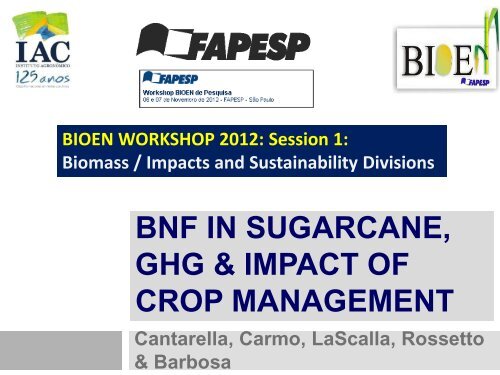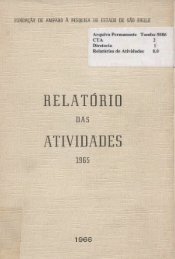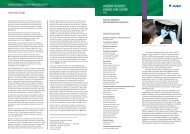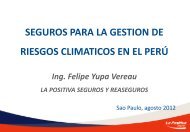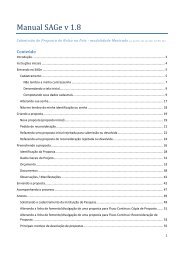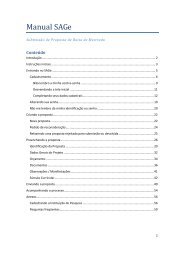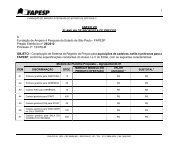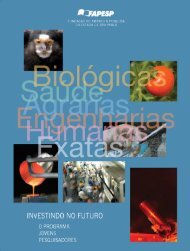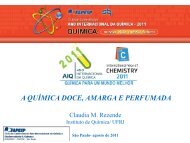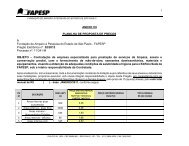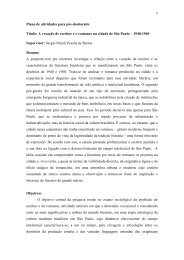bnf in sugarcane, ghg & impact of crop management - Fapesp
bnf in sugarcane, ghg & impact of crop management - Fapesp
bnf in sugarcane, ghg & impact of crop management - Fapesp
You also want an ePaper? Increase the reach of your titles
YUMPU automatically turns print PDFs into web optimized ePapers that Google loves.
BIOEN WORKSHOP 2012: Session 1:<br />
Biomass / Impacts and Susta<strong>in</strong>ability Divisions<br />
BNF IN SUGARCANE,<br />
GHG & IMPACT OF<br />
CROP MANAGEMENT<br />
Cantarella, Carmo, LaScalla, Rossetto<br />
& Barbosa
2<br />
List <strong>of</strong> projects<br />
08/56.147-1 Cantarella N nutrition <strong>of</strong> <strong>sugarcane</strong> with fertilizers<br />
or N-fix<strong>in</strong>g bacteria<br />
08/57937-6 Barbosa Study <strong>of</strong> the transference <strong>of</strong> fixed<br />
nitrogen from the diazotrophic bacteria to<br />
<strong>sugarcane</strong><br />
08/58029-6 Rossetto Concentrated v<strong>in</strong>asse applied to<br />
<strong>sugarcane</strong>: chemical soil characteristics,<br />
ion leach<strong>in</strong>g and agronomic efficiency<br />
08/55989-9 Carmo N2O, CO2 and CH4 emissions from agrobi<strong>of</strong>uel<br />
production <strong>in</strong> São Paulo state,<br />
Brazil.<br />
08/58187-0 LaScala The <strong>impact</strong> <strong>of</strong> tillage and harvest<br />
Bioen Workshop 2012 (Cantarella)<br />
practices on soil CO2 emission <strong>of</strong>
N nutrition <strong>of</strong> <strong>sugarcane</strong> with<br />
fertilizers or N-fix<strong>in</strong>g bacteria<br />
3<br />
Evidences <strong>of</strong> BNF <strong>in</strong> <strong>sugarcane</strong>: an<br />
<strong>in</strong>oculant conta<strong>in</strong><strong>in</strong>g 5 species <strong>of</strong><br />
bacteria was launched <strong>in</strong> 2008<br />
Can we replace (or decrease) m<strong>in</strong>eral N<br />
fertilization?<br />
Objectives<br />
Determ<strong>in</strong>e the extent <strong>of</strong> the contribution <strong>of</strong> BNF compared<br />
with N fertilization <strong>in</strong> a network <strong>of</strong> field experiments<br />
Identify genetic traits <strong>of</strong> <strong>sugarcane</strong> plants related to BNF<br />
that could be used <strong>in</strong> a breed<strong>in</strong>g program<br />
Identify new microorganisms capable <strong>of</strong> stimulat<strong>in</strong>g plant<br />
growth and carry on BNF<br />
Measure GHGs emissions as affected by N fertilization <strong>of</strong><br />
<strong>in</strong>oculation <strong>of</strong> N-fix<strong>in</strong>g microorganisms<br />
Bioen Workshop 2012 (Cantarella)
BNF and N fertilization: field<br />
studies<br />
4<br />
Stalks, t/ha<br />
Stalks, t/ha<br />
125<br />
120<br />
115<br />
110<br />
105<br />
100<br />
90<br />
80<br />
70<br />
60<br />
50<br />
Plant Cane - 5 sites<br />
y = -0.0022N 2 + 0.3975N + 102.6<br />
R² = 0.99<br />
0 20 40 60 80 100<br />
Applied N, kg/ha<br />
Ratoon Cane - 2 sites<br />
y = -0.0009N 2 + 0.2524N + 58.8<br />
R² = 0.98<br />
Bioen Workshop 2012 (Cantarella)<br />
M<strong>in</strong>eral N<br />
Inoculated<br />
N + Inoculation<br />
M<strong>in</strong>eral N<br />
Inoculated<br />
N + Inoculation<br />
0 50 100 150<br />
Applied N, kg/ha<br />
Summary <strong>of</strong> Ma<strong>in</strong> Results:<br />
Mean N fertilizer response: 15 t/ha stalk and 5 t/ha dry<br />
mass<br />
Significant response to N: 3/5 <strong>in</strong> plant cycle and ½ <strong>in</strong><br />
ratoon.<br />
No significant response to <strong>in</strong>oculation <strong>of</strong> N-fix<strong>in</strong>g<br />
bacteria with or without N fertilizer <strong>in</strong> any <strong>of</strong> the<br />
varieties or sites studied<br />
Effect <strong>of</strong> FBN – if significant – may be already built<br />
<strong>in</strong>to the <strong>sugarcane</strong> production system (native<br />
species)<br />
FBN por δ 15 N: 0 to ~70% <strong>of</strong> contribution <strong>of</strong> N from<br />
BNF<br />
Next: 4 new fields harvested <strong>in</strong> 2012<br />
N stock <strong>in</strong> soil (long term effect) to be evaluated<br />
2012
New microrganisms isolated<br />
from <strong>sugarcane</strong> fields: BNF and<br />
PGP<br />
5<br />
Genetic diversity <strong>of</strong> isolates (162) by Box PCR<br />
(From Jaú, SP, cane cultivar IAC-5000)<br />
Isolado - espécie PMSPA<br />
Bioen Workshop 2012 (Cantarella)<br />
g<br />
Redutase<br />
Nitrato<br />
N acum. AIA P Sol. nifH<br />
µmol NO2 g -1 -1<br />
mg pl<br />
µg mg -1<br />
prote<strong>in</strong><br />
mg<br />
mg -1<br />
Delftia acidovorans 11,5a 0,05 131a 2,47 nd -<br />
Delftia acidovorans 10,6a 0,04 143a 0,49 nd -<br />
B Pantoea dispersa 11,0a 0,11 134a 0.04 nd -<br />
Enterobacter cloacae 12,4a 0,03 157a 0.34 nd -<br />
Pantoea dispersa 11,8a 0,04 142a 0,07 1,02 -<br />
A Pantoea dispersa 13,2a 0,07 167a 0,07 1,04 -<br />
Pantoea dispersa 11,3a 0,04 137a 3,73 2,08 -<br />
Herbaspirillum fris<strong>in</strong>gense 12,0a 0,23 152a 0,98 nd -<br />
B Burkholderia caledonica 11,8a 0,14 137a 0,09 3,98 -<br />
Pseudomonas sp. 11,6a 0,03 114b 5,37 nd -<br />
A Enterobacter asburiae 13,4a 0,09 146a 1,91 nd -<br />
B Enterobacter asburiae 11,8a 0,06 137a 1,91 nd -<br />
Methylobacterium fujisawaense 10,4a 0,10 119b 3,43 nd -<br />
Controle 8,0b 0,05 99b -<br />
Ma<strong>in</strong> isolates will be <strong>in</strong>oculated <strong>in</strong><br />
mi<strong>crop</strong>ropaged <strong>sugarcane</strong> plants<br />
168 stra<strong>in</strong>s<br />
89% with BNF capacity<br />
59% with effect similar to aux<strong>in</strong>es
Inoculation <strong>of</strong> 5-bacteria mix to<br />
meristem micro-propagated<br />
<strong>sugarcane</strong> plants<br />
6<br />
60,0<br />
50,0<br />
40,0<br />
30,0<br />
20,0<br />
10,0<br />
0,0<br />
Plant height (cm) 56 days<br />
after <strong>in</strong>oculation<br />
sem <strong>in</strong>ocluante<br />
Bioen Workshop 2012 (Cantarella)<br />
Response to <strong>in</strong>oculation is varietydependent.<br />
Early stage results (PGPB) are good<br />
but it is not clear whether or how they<br />
could be ma<strong>in</strong>ta<strong>in</strong>ed<br />
New cane cultivars are be<strong>in</strong>g tested<br />
Gene expression will be evaluated<br />
IACSP95-5094<br />
No <strong>in</strong>oculation (38.1 cm) Inoculated (52.0 cm)
Study <strong>of</strong> the transference <strong>of</strong> fixed nitrogen<br />
from the diazotrophic bacteria to <strong>sugarcane</strong><br />
7<br />
Several new microorganisms associated<br />
with <strong>sugarcane</strong> have been isolated,<br />
present<strong>in</strong>g different effects and functions<br />
Results presented refer to most recent<br />
research (not published yet).<br />
Sugarcane-bacterial <strong>in</strong>teractions are<br />
promis<strong>in</strong>g areas, to be further studied<br />
Bioen Workshop 2012 (Cantarella)<br />
H. Barbosa et all.
CO-CULTURES AS A MODEL TO STUDY INTERACTIONS BETWEEN<br />
SUGARCANE CALUSES AND DIAZOTROPHIC ENDOPHYFITIC<br />
BACTERIA.<br />
R. C. R. MARTINS AND H. R. BARBOSA<br />
Callus<br />
Co-culture<br />
8<br />
• Influence <strong>of</strong> callus on bacterial growth – STIMULATION x INHIBITION<br />
Callus<br />
log CFU.mL -1<br />
10<br />
9<br />
8<br />
7<br />
6<br />
5<br />
4<br />
3<br />
2<br />
1<br />
Enterobacter sp. (ICB117)<br />
10<br />
9<br />
8<br />
Erw<strong>in</strong>ia sp. (ICB409)<br />
0<br />
0 200 400 600 800 1000 1200<br />
time (h)<br />
log CFU.mL -1<br />
log CFU.mL -1<br />
7<br />
6<br />
5<br />
4<br />
3<br />
2<br />
1<br />
0<br />
0 200 400 600<br />
time (h)<br />
• Influence <strong>of</strong> bacteria on calluses– INCREASE OF PROTEIN<br />
CONTENT-through N-fixation<br />
Culture medium<br />
N comb<strong>in</strong>ed-free<br />
Bioen Workshop 2012 (Cantarella)<br />
prote<strong>in</strong> content <strong>of</strong> calluses<br />
600<br />
500<br />
400<br />
300<br />
200<br />
100<br />
Callus + Erw<strong>in</strong>ia sp.<br />
0<br />
0 200 400 600 800 1000 1200 1400<br />
Time (h)<br />
Callus +<br />
Enterobacter sp.<br />
Callus control
Massa fresca foliar (g)<br />
5<br />
4<br />
3<br />
2<br />
1<br />
0<br />
9<br />
Comprimento foliar (cm)<br />
Inoculation <strong>of</strong> Enterobacter sp. <strong>in</strong> <strong>sugarcane</strong> plantlets S. Ichiwaki, F. I. Ferrara I and<br />
100<br />
80<br />
60<br />
40<br />
20<br />
0<br />
H. R. Barbosa<br />
Fertilization:<br />
Leaf lenght Root volume<br />
a a a a<br />
Orgânico Convencional Sem adubação<br />
Tratamentos (60 DPI)<br />
Orgânico Convencional Sem adubação<br />
Tramamento (60 DPI)<br />
Não <strong>in</strong>oculado Enterobacter<br />
Organic x Conventional<br />
b<br />
a<br />
Vol Radicular (cm³)<br />
8<br />
7<br />
6<br />
5<br />
4<br />
3<br />
2<br />
1<br />
0<br />
b<br />
a<br />
b<br />
Orgânico Convencional Sem adubação<br />
a<br />
Tratamentos (60 DPI)<br />
b<br />
a<br />
Clor<strong>of</strong>ila<br />
Growth parameters: organic = conventional<br />
Prote<strong>in</strong> content: Enterobacter sp. + organic = conventional<br />
50<br />
40<br />
30<br />
20<br />
10<br />
0<br />
a<br />
Chlorophyll<br />
a a a a<br />
Orgânico Convencional Sem adubação<br />
Tratamentos (60 DPI)<br />
Leaf fresh weigh Root fresh weigh Leaf dry weigh<br />
Root dry weigh<br />
a a a a<br />
Control<br />
Inoculated x Fertilized<br />
b<br />
Bioen Workshop 2012 (Cantarella)<br />
c<br />
Massa fresca radicular (g)<br />
5<br />
4<br />
3<br />
2<br />
1<br />
0<br />
a<br />
b b b<br />
a c<br />
Orgânico Convencional Sem adubação<br />
Tratamento (60DPI)<br />
Massa seca foliar (g)<br />
1<br />
0,8<br />
Não 0,6 <strong>in</strong>oculado<br />
Enterobacter<br />
0,4<br />
0,2<br />
0<br />
a a<br />
a a<br />
Orgânico Convencional Sem adubação<br />
Tratamentos (60 DPI)<br />
b<br />
a<br />
Massa seca radicular (g)<br />
1<br />
0,8<br />
0,6<br />
0,4<br />
0,2<br />
0<br />
b<br />
a a a a a<br />
b<br />
Orgânico Convencional Sem adubação<br />
Tratamentos (60 DPI)<br />
Growth parameters and prote<strong>in</strong> content: Always the lowest<br />
Growth parameters: Inoculated = organic and conventional<br />
Prote<strong>in</strong> content: Inoculated = Enterobacter sp. + organic<br />
and conventional
10<br />
Leaf size<br />
O EO C EC S ES<br />
Comparação entre comprimentos foliares de plântulas não <strong>in</strong>oculadas e <strong>in</strong>oculadas 60<br />
DPI.<br />
Clorose<br />
O C S<br />
Diferença na pigmentação foliar em plântulas<br />
não <strong>in</strong>oculadas.<br />
Foto por: Ichiwaki (2012).<br />
Enterobacter<br />
EC EO ES S Foto por: Ichiwaki (2012).<br />
Diferença entre os comprimentos foliares de plântulas de canade-açúcar<br />
<strong>in</strong>oculadas com Enterobacter sp. ICB481 e plântula<br />
do grupo sem adubação, após 60 DPI.<br />
EO EC ES<br />
Ausência de amarelecimento foliar nos grupos<br />
<strong>in</strong>oculados com Enterobacter sp. ICB481 aos 60 DPI.<br />
Legenda: Grupos Orgânico (O), Enterobacter-orgânico (EO) / Convencional (C), Enterobacter-convencional / Sem<br />
adubação (S) e ES= Enterobacter-sem adubação.<br />
Foto por: Ichiwaki (2012).<br />
Foto por: Ichiwaki (2012).
11<br />
GHGs emission: suste<strong>in</strong>ability <strong>of</strong><br />
ethanol production<br />
GHG emissions reduction due to<br />
ethanol replacement <strong>of</strong> fossil fuels<br />
51 – 65% (Boddey et al., 2008)<br />
85% (Börjesson, 2009)<br />
81 and 24% to 1 st and 2 nd generation (Luo et al.,<br />
2009)<br />
Emission associated with<br />
fertilizer use<br />
N 2O releas<strong>in</strong>g from soils/fertilizers<br />
could <strong>of</strong>fset the benefits <strong>of</strong> avoid<strong>in</strong>g<br />
CO 2 from fossil fuels (Scharlemann &<br />
Laurence, 2008; Crutzen et al., 2008).<br />
High N 2O values found <strong>in</strong> other<br />
important cane producer countries<br />
(Denmead et al., 2009; Allen et al., 2010)<br />
IPCC Bioen Workshop standard: 2012 (Cantarella) 1% (IPCC, 2006)
N 2O (mg N m -2 )<br />
CH 4 (mg N m -2 )<br />
12<br />
GHGs emission: fertilizer X<br />
<strong>in</strong>oculation<br />
300<br />
250<br />
200<br />
150<br />
100<br />
50<br />
0<br />
0<br />
-10<br />
-20<br />
-30<br />
-40<br />
-50<br />
Nitrous Oxide<br />
N0 N0+I N100 N150<br />
N0 N0+I N100 N150<br />
Methane<br />
Jaú (Burned)<br />
Clay: 17.8%; Sand: 76.6%<br />
Bulk density: 1.39 g cm -3<br />
Carbon: 2114 g C m -2<br />
Bioen Workshop 2012 (Cantarella)<br />
N 2O (mg N m -2 )<br />
CH 4 (mg C m -2 )<br />
300<br />
250<br />
200<br />
150<br />
100<br />
50<br />
0<br />
0<br />
-10<br />
-20<br />
-30<br />
-40<br />
-50<br />
Nitrous Oxide<br />
N0 N0+I N100 N150<br />
N0 N0+I N100 N150<br />
Methane<br />
Piracicaba (Unburned)<br />
Clay: 51.9%; Sand: 31.4%<br />
Bulk density: 1.49 g cm -3<br />
Carbon: 4090 g C m -2<br />
N 2O emission <strong>in</strong>creased<br />
with N fertilizer application<br />
but was not affected by<br />
<strong>in</strong>oculation with diazotrhopic<br />
bacteria<br />
Emission factor ≤ IPCC<br />
Vargas et al, 2012)
Emission factor (fertilizer, trash,<br />
v<strong>in</strong>asse)<br />
13<br />
Trash rate V<strong>in</strong>asse<br />
Mg ha-1 Mg ha-1 Added<br />
N<br />
£ Added N<br />
emission factor<br />
kg ha-1 kg ha (%)<br />
-1 (%)<br />
§ CO2<br />
equivalent<br />
kg CO2 eq. ha-1 kg CO2 eq. ha-1 yr-1 yr-1 0 With 142 0.59±0.29 1,289<br />
Without 120 0.68±0.41 382<br />
7 With 142 1.19±0.84 1,620<br />
Without 120 0.96±0.46 540<br />
14 With 142 1.89±1.00 3,005<br />
Without 120 0.76±0.30 427<br />
21 With 142 3.03±1.22 3,060<br />
Without 120 2.03±1.15 1,141<br />
Bioen Workshop 2012 (Cantarella)<br />
Carmo et al. 2012 (GCB-Bioenergy)
N 2O Emission, kg N-N 2O/ha<br />
4<br />
3<br />
2<br />
1<br />
0<br />
N 2O = 0,0056x 2 + 0,0207x + 0,78<br />
R² = 0,99<br />
N 2O = 0,0496x + 0,692<br />
R² = 0,62<br />
0 5 10 15 20 25<br />
Sugarcane trash, t/ha<br />
Trash+v<strong>in</strong><br />
Trash<br />
N 2O emission from N<br />
fertilizer <strong>in</strong> <strong>sugarcane</strong> is<br />
with<strong>in</strong> or bellow the<br />
IPPC default value but<br />
the addition <strong>of</strong> organic<br />
residues caused<br />
<strong>in</strong>crease N 2O emission.<br />
Remov<strong>in</strong>g excess trash<br />
from the field (for<br />
energy production) may<br />
avoid high N 2O emission<br />
Increase <strong>of</strong> N emission factor for fertilizer N (ammonium nitrate surface-applied):<br />
Trash 0,04% per t/ha <strong>of</strong> trash left on soil<br />
Trash+v<strong>in</strong>asse 0,12% per t/ha trash left on soil
15<br />
Nitrification <strong>in</strong>hibitor<br />
decreases N 2O emission<br />
Trash<br />
(Mg ha -1 ) + N<br />
(100 kg/ha)<br />
Bioen Workshop 2012 (Cantarella)<br />
Days after fertilization<br />
N2O emission (mg N/m 2 ) Reduction <strong>in</strong> N2O<br />
emission due to<br />
No DCD With DCD<br />
DCD<br />
0 10,89 bA § 3,85 aB 65%<br />
8 15,92 bA 5,91 aB 63%<br />
16 32,04 aA 8,44 aB 74%<br />
(Vargas et al, 2012)
Concentrated v<strong>in</strong>asse <strong>in</strong> <strong>sugarcane</strong>: soil<br />
chemical attributes, ion lixiviation and<br />
agronomic efficiency<br />
16<br />
V<strong>in</strong>asse: 10 to 13 L/L ethanol<br />
Large amounts generated: high cost <strong>of</strong> application, risk <strong>of</strong> soil and ground water<br />
contam<strong>in</strong>ation with nutrients<br />
Concentrated v<strong>in</strong>asse: high cost (and energy) to remove water. Easier and cheaper<br />
field application<br />
Treatments: 0, 120, 140, 360 kg/ha K 2O (as KCl, normal or concentrated v<strong>in</strong>asse)<br />
Bioen Workshop 2012 (Cantarella)<br />
Rossetto et al, (2012)
17<br />
Monitor<strong>in</strong>g: <strong>of</strong> K, NO 3, Cl, etc...<br />
Soil – 0-25,25-50, 50-80cm depth<br />
Samples <strong>in</strong> each plot every 3 months<br />
Leach<strong>in</strong>g ions - soil solution extraction –<br />
0- 80cm depth<br />
•Diagnosis Solo –<br />
leave<br />
camadas<br />
– top<br />
0-10,10-20,<br />
visible dewlap<br />
até 1,20m<br />
Macronutrients analysis<br />
Plant – leaves, stalks (bagasse + juice), roots<br />
Straw<br />
Samples taken before harvest<br />
Bioen Workshop 2012 (Cantarella)
V<strong>in</strong>asse: ma<strong>in</strong> results<br />
18<br />
N m<strong>in</strong>eralization <strong>in</strong> concentrated v<strong>in</strong>asse is slower. Half life 6<br />
weeks (3 <strong>in</strong> conventional v<strong>in</strong>asse): longer N availability<br />
V<strong>in</strong>asse improved soil fertility (SOM, N, K, P, Ca). Higher rate <strong>of</strong><br />
CV <strong>in</strong>crease K saturation up to 2.2% <strong>of</strong> CEC <strong>in</strong> topsoil<br />
(legislation limit is 5%)<br />
Ca, K, N and P were concentrated <strong>in</strong> the soil surface layer. Mg<br />
was well distributed ; SO4 was more concentrated <strong>in</strong> deep<br />
layers.<br />
Sugarcane yield <strong>in</strong>creased with v<strong>in</strong>asse application (+12<br />
ton/ha). Enhanced nutrient extraction contributed to avoid<br />
accumulation <strong>of</strong> nutrients <strong>in</strong> soil.<br />
No negative effect <strong>of</strong> v<strong>in</strong>asse was observed, even at high K<br />
rates<br />
Bioen Workshop 2012 (Cantarella)
Tillage and harvest practices on soil CO 2<br />
emission <strong>in</strong> <strong>sugarcane</strong> production areas<br />
19<br />
Bioen Workshop 2012 (Cantarella)<br />
Burn<strong>in</strong>g <strong>sugarcane</strong> before<br />
harvest is be<strong>in</strong>g phased<br />
out.<br />
The effect <strong>of</strong> such change<br />
on soil properties &<br />
susta<strong>in</strong>ability must be<br />
exam<strong>in</strong>ed.<br />
LaScalla & collaborators are study<strong>in</strong>g<br />
the effect <strong>of</strong> green cane harvest<strong>in</strong>g on<br />
soil C, along with practices such as<br />
no-till and conventional till
20<br />
GHG balance <strong>of</strong> cane production:<br />
Green cane decreases CO 2 emission<br />
Source<br />
Synthetic Fertilizer<br />
V<strong>in</strong>asse<br />
Filter Cake<br />
Harvest Residues<br />
Residues Burn<strong>in</strong>g<br />
Lim<strong>in</strong>g<br />
Diesel<br />
Sub-Total:<br />
C sequestration<br />
Total:<br />
1,173<br />
-2500 -2000 -1500 -1000 -500 0 500 1000 1500 2000 2500 3000<br />
Bioen Workshop 2012 (Cantarella)<br />
Burned harvest Green harvest<br />
CO 2 eq emission (kg ha -1 y -1 )<br />
1,620<br />
2,793<br />
3,104<br />
3,104<br />
Conversion to green cane<br />
could save the equivalent<br />
<strong>of</strong> 311 kg CO 2 ha -1 yr -1 ,<br />
or 1484 kg CO 2 ha -1 yr -1 if<br />
soil C sequestration is<br />
computed<br />
2011<br />
Figueiredo et al., 2011
21<br />
Effect <strong>of</strong> tillage on CO 2 emission<br />
under burned or green cane<br />
Total Emission (kg CO 2 -C hectare -1 )<br />
1750<br />
1500<br />
1250<br />
1000<br />
750<br />
500<br />
250<br />
0<br />
525.4<br />
808.8<br />
BH<br />
953.9<br />
1093.5<br />
NT Cn CnLi CnLiG NT Cn CnLi CnLiG NT Cn CnLi CnLiG<br />
Bioen Workshop 2012 (Cantarella)<br />
698.8<br />
GHnores<br />
284 kg C-CO 2 ha -1 247 kg C-CO 2 ha -1<br />
944.5<br />
1065.0<br />
1081.8<br />
Treatment<br />
= 1039 kg C-CO 2 ha -1 (3808 kg CO 2)<br />
Em 25 days after tillage<br />
446.4<br />
GHres<br />
1485.1<br />
1266.9<br />
1550.2<br />
Plow<strong>in</strong>g the soil<br />
promotes large<br />
CO 2 emissions,<br />
especially <strong>in</strong> areas<br />
with trash (plant<br />
residues) <strong>of</strong> GH<br />
BH: burned harved<br />
GH: green cane<br />
(with or without<br />
residues)<br />
NT: no till<br />
CN: conventional<br />
tillage Figueiredo et al., 2011
Conclud<strong>in</strong>g remarks<br />
22<br />
Inoculation <strong>of</strong> <strong>sugarcane</strong> with endophytic bacteria is<br />
not result<strong>in</strong>g <strong>in</strong> yield ga<strong>in</strong>s or apparent N<br />
substitution under field conditions<br />
Controlled conditions: promis<strong>in</strong>g results, variety-dependent.<br />
PGP properties. Practical benefits <strong>of</strong> endophytic and<br />
rhizobacterias are still a challenge.<br />
Sugarcane <strong>in</strong>dustry by-products can be susta<strong>in</strong>ably<br />
used <strong>in</strong> the field. Subject deserves more studies<br />
GHGs emission: large volume <strong>of</strong> good quality data is<br />
be<strong>in</strong>g generated.<br />
C balance: projects under way with good prospects.<br />
Enormous challenge.<br />
Bioen Workshop 2012 (Cantarella)
Thank you<br />
cantarella@iac.sp.gov.br<br />
Thai Delegation Meet<strong>in</strong>g 16-8-2012<br />
23


